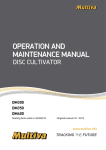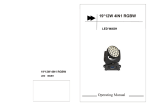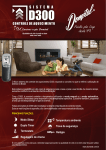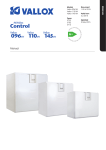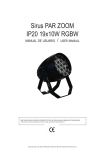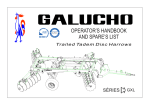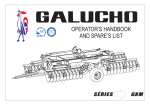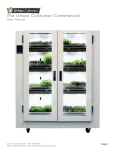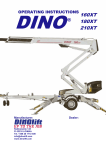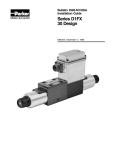Download OPERATING AND MAINTENANCE MANUAL
Transcript
OPERATING AND MAINTENANCE MANUAL CULTIVATOR WingMaster Starting from 2012 Original manual 01 / 2012 Contents 1. FOREWORD............................................................................................................................................................................1 1.1. Intended use of the machine ......................................................................................................................................1 1.2. Technical specifications.................................................................................................................................................2 1.3. Type plate...........................................................................................................................................................................2 2. SAFETY INSTRUCTIONS......................................................................................................................................................3 2.1. Warning symbols .............................................................................................................................................................3 2.2. Hitching and unhitching...............................................................................................................................................3 2.3. Transport on public roads ............................................................................................................................................3 2.4. Use of the cultivator........................................................................................................................................................4 2.5. Maintenance......................................................................................................................................................................4 3. COMMISSIONING AND ADJUSTMENTS........................................................................................................................5 3.1. Measures before commissioning...............................................................................................................................5 3.2. Hitching to tractor...........................................................................................................................................................5 3.3. Adjusting hydraulic hoses (semi-mounted)...........................................................................................................6 3.4. Basic adjustment of the machine position.............................................................................................................7 3.5. Adjusting working depth..............................................................................................................................................7 3.6. Adjustment of the levelling discs...............................................................................................................................8 3.7. Actuator power adjustment ........................................................................................................................................8 3.8. Roller scraper adjustment.............................................................................................................................................8 4. STUBBLE CULTIVATION......................................................................................................................................................9 4.1. Cultivation techniques...................................................................................................................................................9 5. 6. MAINTENANCE, INSPECTIONS...................................................................................................................................... 11 5.1. Inspections after 10 hours of use ............................................................................................................................ 11 5.2. Check every 100 hours or once in an operating period.................................................................................. 11 MAINTENANCE, LUBRICATION..................................................................................................................................... 13 6.1. Lubrication every 10 hours or daily........................................................................................................................ 13 6.2. Lubrication every 50 h (semi-mounted)............................................................................................................... 13 6.3. Lubrication every 100 hours or once in an operating period....................................................................... 13 6.4. Lubrication every 1000 h (semi-mounted).......................................................................................................... 14 7. CONSUMABLE PARTS...................................................................................................................................................... 14 8. STORAGE.............................................................................................................................................................................. 14 8.1. Washing and cleaning................................................................................................................................................. 14 9. WARRANTY ......................................................................................................................................................................... 15 10. EC DECLARATION OF CONFORMITY FOR THE MACHINE ................................................................................... 17 1. FOREWORD Multiva agricultural machines are manufactured in Finland. The modern technology, good raw materials and careful manufacturing and finishing utilised in the production of the machines guarantee a high quality product. The Multiva product range includes, among others, the following agricultural machines: • Trailers • S-Tine Harrows • Disc Harrows • Cultivators We thank you for choosing and placing your trust on the Multiva Cultivator. We hope that the product fulfils your requirements and serves you for a long time. We advise you to carefully go through these instructions before commissioning the machine. The inspection and maintenance activities described in these instructions are vitally important for the proper functioning of the machine and the validity of the warranty. All instructions, warnings and cautions must be followed without exception. They are given to ensure the safety of the user and the durability of the machine. These operating and maintenance instructions cover WingMaster range cultivators starting from model year 2012. 1.1. Intended use of the machine Multiva cultivator is intended for primary tillage in spring or autumn that has the primary function of aerating the soil, covering crop residues and preparing the soil for following cultivating activities. The cultivator should not be used for any other purposes! Cultivation is so-called reduced tillage, in which the soil is moved as little as possible and the crop residues are turned under in the surface layer of the soil. The cultivator is particularly suitable for reduced tillage, as its working method is tearing, its working depth can be precisely adjusted and it prevents root weeds better than other reduced tillage machines. 1 1.2. Technical specifications With standard equipment 300-2 360H WingMaster 7 12 Number of tines 42.5 30 Tine spacing cm 2 3 Number of tine axles 300 360 Working width cm 312 400 Transport width cm Power requirement hp 100/150 150/180 1970 3300 Weight kg All models have hydraulic actuators the power of which can be adjusted with hydraulic accumulator. The levelling discs and roller are a standard equipment of the cultivator. You can find the technical specifications on the manufacturer's website. Please contact the manufacturer to acquire information about new products. Due to ongoing product development, products and specifications discussed herein are subject to change. 1.3. Type plate A type plate similar to the one below is attached to the cultivator. Please write all the information from the type plate in this manual. When you are dealing with the supplier of the Multiva machine or a factory representative, please mention the model and serial number of the machine. This is recommended to avoid delays and unnecessary misunderstandings. 2 2. SAFETY INSTRUCTIONS These safety instructions and safety distances must without exception be taken into account and followed when using the machine. Never allow any person to ride the machine during work or transport! 2.1. Warning symbols Follow the warning labels attached to the machine pictured below. Do not remove the warning labels. Warning symbols Purpose THE OPERATING MANUAL AND PARTICULARLY THE SAFETY INSTRUCTIONS MUST BE READ THOROUGHLY BEFORE HITCHING THE MACHINE TO THE TRACTOR! DANGER OF CRUSHING! WHEN THE MACHINE IS IN USE, KEEP A 5METRE SAFETY DISTANCE TO IT. THE MACHINE HAS A HYDRAULIC ACCUMULATOR! HIGH-PRESSURE OIL SPRAY MAY PENETRATE THE SKIN AND CAUSE SEVERE INJURY! 2.2. Hitching and unhitching The hitching system attached machine should only be fixed to a three-point hitching device of a tractor. The semi-mounted machine can only be attached to the lower link arms. All safety instructions of the tractor must be followed when hitching or unhitching the machine. There is a danger of crushing in hitching and unhitching activities. Also beware the bruising of feet, fingers and arms. Do not disconnect pressurised hydraulic connectors. Never touch the hydraulic cylinders, hoses or connectors when the cylinders are activated. When the machine is hitched to a tractor, unauthorized persons should not stand near the harrow. 2.3. Transport on public roads When transporting machine on public roads, please take into account and follow all orders under the Road Traffic Act and special regulations concerning slow vehicles. Before moving, check the visibility of the machine's reflectors and the slow vehicle triangle as well as the functioning and visibility of the tractor's lights. Always ensure that the machine is sufficiently clean before transport on public roads. 3 The machine should not be operated when tired, under the influence of alcohol or affected by a medical condition that may affect one's performance. The operator is responsible for the damages caused to people by the machine. The greatest allowed transport speed for the semi-mounted cultivator is 40 km/h. On roads that are in poor condition, the speed should be lower. 2.4. Use of the cultivator The operator must be familiar with the operation of the cultivator and he/she must have the knowledge and skills to operate it correctly. The operator must study the operating instructions and follow them. The condition of the cultivator and the tightness of the bolts must always be visually checked before starting work. Never adjust or clean a moving machine. During work, persons are forbidden to ride the machine or stand within the working area (safety distance 5 m). The safety distance should also be kept when the machine is not moving while the hydraulics are being used. Pressurised hydraulic cables can release a deadly liquid spray. Do not reverse the machine while the tines are in the soil. Do not make any sharp turn with the machine when the tines are in the soil, lift the tines up for sharp turns. When attaching the hitching device attached machine to the tractor, the distribution of weight between the front and rear axles of the tractor changes. To achieve safe working and best pulling power, install front weights to the tractor if necessary. 2.5. Maintenance For maintenance, the machine must be stopped and it must be blocked to stop it from moving. Maintenance must be carried out on an even and stable surface to prevent the machine from tipping over or moving. Maintenance-related and other measures should not be carried out when the machine or one of its parts is raised and unsupported. When carrying out maintenance on the machine, ensure safe working conditions and sufficient lighting. Only use original spare parts in the maintenance. Using non-original spare parts will void the warranty. 4 3. COMMISSIONING AND ADJUSTMENTS 3.1. Measures before commissioning The sections of the machine requiring lubrication have been lubricated at the factory and oil has been driven to the cylinders during test runs. Still, it is recommended to review the lubrication points before the first period of usage. Lubrication points are described in section6of this manual: MAINTENANCE, LUBRICATION. 3.2. Hitching to tractor The pressure control hose is not marked. The hose does not have to be connected to the tractor, but if it is not connected, tie it to the machine so that it does not become damaged. Hitching device attached 300-2: Attach to the 3-point hitching device of the tractor. The fixing point of the upper link arm in the tractor must be located below than that of the machine. The pins of pulling arms and piston rods are locked with ring pins. Adjust the side limiters of the tractor so that they lock the tiller to the centre in the hitching devices. The correct adjustment prevents the machine from touching the tractor or its tires. The hoses of the actuator hydraulics of the working depth adjustment are connected to a dual action output. When you unhitch the machine from the tractor, remember to also disconnect the hydraulic connectors. Action Working depth - down Working depth - up Marking the hose 1 x blue 2 x blue Semi-mounted 360H: Attach the machine to the pulling arms of the tractor. The pulling arms of the tractor must be left as horizontal as possible. The pulling arms should never be directed downwards, as this will prevent the working depth from remaining consistent. The side limiters must without exception be locked. The tractor must have 2 dual action hydraulic outputs. Action Marking the hose Working depth - down 1 x blue Working depth - up 2 x blue Transport wheels - up (tap) 1 x red Transport wheel - down 2 x red When you unhitch the machine from the tractor, always remember to also disconnect the hydraulic connectors. Remember that pressurised hoses should never be handled and the hydraulics should be depressurised before handling. 5 3.3. Adjusting hydraulic hoses (semi-mounted) Picture 1. Hose rack After hitching the machine to the tractor, adjust the hydraulic hoses between the hose rack and tractor to a suitable length. The length of the hoses can be adjusted by loosening the hose rack lock (point 1 in the illustration, x 3). Extra hose is left looped in the rack. Tighten the bolts after making the adjustment. The length of the hoses is correct when the hoses do not become in contact with the tractor's pulling arms during turning. The length of the hoses is too short if they tense up and disconnect from the tractor's hydraulic connector during turning. The smallest allowed diameter for a hose loop is 200 mm. If the diameter is too small, the loop must be opened and the hoses placed on the rack without looping. If the loop is too small, there is a danger of breaking the houses. 6 3.4. Basic adjustment of the machine position The lateral position of the machine attached to the hitching device is adjusted by setting the tractor pulling arms to the same height so that the cultivator is level with the tractor. The longitudinal levelness of the frame is adjusted by changing the length of the piston rod. During tillage, the frame of the machine must be both laterally and longitudinally level with the ground. The semi-mounted machine is adjusted level by changing the length of the drawbar top link (picture 2, point 1). When changing the working depth, the machine position must be levelled again. 1 Picture 2. Semi-mounted cultivator 3.5. Adjusting working depth Working depth is adjusted in all models by changing the height of the levelling roller in relation to the frame of the machine. The adjustments are made with the adjustment pieces of the working depth cylinder. By reducing the thickness of the adjustment pieces, the working depth increases and by increasing their thickness, the working depth decreases. Working depth is adjusted to suit each field block. Picture 3. Depth adjustment 7 By reducing the thickness of the adjustment pieces (moving right in the table), the working depth increases and by increasing their thickness (moving left), the working depth decreases. For instance, a 50 mm working depth can be achieved with the combination: black + blue + yellow adjustment piece. The scale shows the reference working depth. True working depth should always be measured from the tilled ground. - 60 B B B B BL B R BL Y BL B - blue BL - black R- red Y - yellow 0 B B BL Y R R B B 25 R R Y BL R Y 50 BL B Y B B Y 75 B B R B B BL 100 BL Y R R 125 B R B BL 150 B B R 3/4" 7/8" 1" 1 1/4" 3.6. Adjustment of the levelling discs Height adjustment of the levelling discs is carried out with two cranks. The outer discs can be raised up during transport. 3.7. Actuator power adjustment The standard pressure in the system is 130 - 150 bar. To adjust the pressure, connect the hose of the hydraulic accumulator to the tractor. Open the valve. The hitched model has the valve at the cultivator end, in other models, the valve is located at the end of the quick connector. The pressure is decreased by releasing pressure to the tractor with the block valve and added by opening the block valve. After making the adjustments, close the tap and release pressure with the block valve before disconnecting the hose. 3.8. Roller scraper adjustment The cleaning scrapers of the roller disc row have two pin-adjusted positions (picture 4. point 1) Adjust the scrapers to suit the working conditions to ensure that the roller discs do not become clogged. The upper adjustment hole (the outer position of the scraper) is the normal adjustment. The lower adjustment hole (the inner position of the scraper) should be used if the soil types have a tendency of clogging the machine. Picture 4. Roller scraper adjustment 8 4. STUBBLE CULTIVATION Cultivation is a method in which the basic tillage of the field is not performed by ploughing. Cultivation moves as little soil as possible and the working depth is usually lower than in ploughing, and this allows that the crop residues are turned under in the surface layer of the soil. Energy and time consumption per unit area is lower compared to ploughing. After cultivation, the surface of the field should be even and the plant residues should not interrupt following work phases. The driving lines should be chosen to minimise the washing of soil material to waterways caused by the flow of surface water. Several studies have showed that the soil structure and the amount of organic matter in the soil both improve in the long term. When cultivation is utilised, this can be seen as an increase in the number of worms and microbes as well as the amount of organic matter. Working becomes easier, the moisture conditions of the soil improve and the soil becomes less prone to silting. Depending on the field, the change may take several years. One must take care not to weaken the improved soil structure by cultivating soil that is excessively wet. Working depth and number of passes must be selected to suit the situation and conditions. The choices are affected by the amount of straw, stubble length and the moisture of the soil. The stubble of the field to be cultivated must not be too long and the straw must be well chopped. 4.1. Cultivation techniques The cultivation technique should be carefully selected. The selection of the cultivation technique is influenced by several factors, e.g. the size and form as well as the surface form and drainage of the block. Correctly selected cultivation technique reduces required work and ensures the best possible result. If possible, it is recommended to drive parallel to the longest side of the block to minimise the time spent on turning. Below are some examples of cultivation techniques. Boundary strip turns can be performed with the semi-mounted machine either on the roller or the wheels. The turn radius is smaller when the machine is using the wheels. When reversing the machine, only transport wheels can be used. The roller may become clogged if reversing is attempted when it is lowered. During cultivation, the wheels should be raised up. This way the wheels stay cleaner and no unnecessary soil material will be transported on the roads.. 9 Cultivation patterns: 1 = spiral pattern 2 = strip pattern 3 = strip pattern, overlaps Turning techniques in strip patterns: 1 = overlap turn 2 = loop turn 3 = reverse turn Turning techniques in spiral patterns 1 = loop turn 2 = reverse turn 10 5. MAINTENANCE, INSPECTIONS 5.1. Inspections after 10 hours of use Check the tightness of all bolts The bolts may become loose during the first hectares. Tightening torques: Tine fixing bolts M16, 10.9, av 24 mm 280 Nm Tine end-pieces M12, 10.9, av 19 mm 120 Nm Roller bearing fixing 210 Nm Semi-mounted: Wheel nuts 320 Nm Tyre pressures (semi-mounted) The tyre pressures must be checked after 10 hours of use. The correct tyre pressure for 400/60-15.5 tires is 2.0 bar. 5.2. Check every 100 hours or once in an operating period Condition of hydraulic hoses • The condition of hydraulic hoses must be checked annually at the beginning of the operating period. • The hoses must be checked for cuts, wear and deformations. • When you check the hoses, be particularly careful not to let the oil spray which may shoot out from the hoses become into contact with your skin. The spray may penetrate clothing and skin. 11 Wheel hub bearing clearance (semi-mounted) The bearing spacing check is very important to perform particularly after the first period of use, after which the bearings have settled to their place and there might be play in the hubs. • If there is play in the bearings of the hubs, they must be tightened. • When you tighten the bearing, lift the wheel off the ground and open the bearing cup. Remove the locking pin of the castle nut of the axle and tighten the nut until you feel slight resistance in the bearing. After this, loosen the nut until the locking pin fits the hole of the next nut, where the bearing is freely rotating. The nut may be loosened only a maximum of 30 degrees. Lock the locking pin in place. Install the bearing cup. 12 6. MAINTENANCE, LUBRICATION 2 3 1 4 5 6 Lubrication points Lubricant is inserted into the nipples until clean lubricant comes out. Excess lubricant should be wiped off with a cloth. Insert a few drops of lubricant into the rocker bearings. All lubrication points must be re-lubricated after the machine has been washed. DO NOT use a spray cleaner to directly spray the labels or parts with bearings. Maintain a minimum distance of 30 cm between the nozzle of the jet cleaner and the sprayed target. Clean the lubrication nipples before lubrication. Wipe off excess lubricant. In all points, the lubricant grease must be applied in the nipple until excess clean grease can be seen coming out of the target. The lubricant should be general purpose grease that contains lithium soap and EP additives. So called pin greases (viscous and adhesive) should never be used to lubricate the machine. Using this type of grease may damage the bearings. 6.1. Lubrication every 10 hours or daily • Roller end bearings 2 pcs, point 6. 6.2. Lubrication every 50 h (semi-mounted) • Drawbar pin bearings, 2 pcs, section 1. 6.3. Lubrication every 100 hours or once in an operating period. • Levelling disc adjustment threaded rods, point 4. 13 • • • • Tine and cylinder hinge pins, 2 pcs / tine, point 3. Working depth cylinder rocker bearings. Wheel cylinder rocker bearings (semi-mounted). Drawbar link rod, point 2 (semi-mounted). 6.4. Lubrication every 1000 h (semi-mounted) • Wheel hub grease renewal 2 pcs, point. Old grease must be completely removed and all parts must be cleaned with diesel oil. The bearing space and 1/3 of the cup volume is filled up with new grease. Wheel hubs must be lubricated with lithium-based vaseline with a minimum drop point of 190º C. 7. CONSUMABLE PARTS In spare part and equipment issues, we recommend contacting the supplier or the manufacturer of the machine. By using original spare parts, you ensure that the machine stays in working order and functions as required. 8. STORAGE The machine must be cleaned and lubricated carefully for long term storage, and it is recommended to store the machine indoors. The hydraulic cylinders should be set to reveal a minimum amount of the chromed piston rod during storage. The uncovered piston rod sections must be protected with petrolatum or thick oil. 8.1. Washing and cleaning When you wash the machine with a jet cleaner, avoid directing the spray towards the levelling disc bearings. Water can penetrate the sealing and replace the lubricant. This will very quickly cause the bearings to fail. Dirt surrounding the bearings must be mechanically removed before using the jet cleaner. After washing, all lubrication points must be lubricated. 14 9. WARRANTY We provide a one year warranty for Multiva agricultural machines. Warranty conditions: 1. During the warranty period, the manufacturer shall replace all defective parts at its own expense when the part failure has been a result of defects in workmanship or material. However, the warranty does not apply to consumable parts. 2. The warranty does not cover damages resulting from: misuse, insufficient maintenance, modifications made without the approval of the manufacturer, traffic accidents or other reasons beyond the manufacturer's control. 3. The warranty does not cover damages resulting from using the machine with a clearly oversized tractor. 4. If the defect discovered during the warranty period is repaired by a third party, the manufacturer shall cover the repair costs only if this arrangement has been agreed beforehand. 5. The manufacturer is not responsible for any loss of profits deriving from downtime or other indirect losses that a defect in the machine may possibly cause. 15 16 10. EC DECLARATION OF CONFORMITY FOR THE MACHINE Dometal Oy Kotimäentie 1 32210 Loimaa Suomi Finland hereby certifies that the sold Multiva WingMaster cultivator conforms to the requirements of the EC Declaration of Conformity for Machines, Directive 98/37/EC. The design of the machine is in compliance with the following harmonised standards: SFS-EN ISO 12100-1:2003 SFS-EN ISO 12100-2:2003 In addition, the following standards have been utilised in the design of the machine: SFS-ISO 5692-1:2005 SFS-ISO 730-1:1994 SFS-EN 1553:2000 SFS-EN 982:1996 17





















